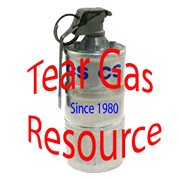Chemical Agent Instructors should be involved in developing their agencies policies. When developing departmental policy it is important to understand the differences between policy and procedure. Policy is defined as the job or task that is to be done. Procedures are how that job or task is to be accomplished. Many policies adopted by organizations are in fact procedures, and vice-versa. Policy formulation is a form of decision—making. When making policy and procedure decisions, agencies may chose a particular course of action from many alternatives. This discussion applies to chemical agents other than hand-held, personal protection devices carried by individual officers.
There are many facets to be considered when formulating policy and procedures that deal with a department’s chemical agent use. Some of the important areas are:
1. Patrol Use versus Tactical Use
Should policy and procedure differ between the two areas? Should patrol even have chemical agents available to them? Many agencies allow only its tactical units to carry and deploy chemical agents. This is a usually a result of lack of training for patrol personnel in the use of chemical agents. Should there be two policies, one for patrol and one for tactical units?
2. Underlying Philosophy
 What should the underlying philosophy be regarding the use of chemical agents? Should agents be used in an offensive manner versus a defensive manner? Many departments restrict the use of chemical agents to defensive use only. This is usually due to a misinterpretation of the laws on the part of policy formulators. Should the philosophy of the use (offensive versus defensive) of hand—held aerosols be different than that of riot control agents? Most departments don’t differentiate between the two, but should.
What should the underlying philosophy be regarding the use of chemical agents? Should agents be used in an offensive manner versus a defensive manner? Many departments restrict the use of chemical agents to defensive use only. This is usually due to a misinterpretation of the laws on the part of policy formulators. Should the philosophy of the use (offensive versus defensive) of hand—held aerosols be different than that of riot control agents? Most departments don’t differentiate between the two, but should.
3. Authorization Levels
What level of supervision should authorize the use of chemical agents? Should the use of chemical agents be authorized by the agency and delegated to some other level of authority, or should the authorization for use be left to the field deputy? Should these authorization levels be different for hand-held aerosols versus riot control agents?
4. Agent Inventory
What agents should be employed in different situations? — Should the agency use CS, CN, OC, Mace, DM or CR? Should the agency posses and use agents that are not authorized by the State of California? How many different situations should be covered, if any?
5. Storage
Where should agents be stored? In a central repository or decentralized locations? Many agencies store them in supervisor’s vehicles. Can the various stored chemical agents stand up to the elements in the vehicle trunk? Is the centralized area safe from the elements? Who is allowed access to the storage points?
6. Purchase of Agents
Who will purchase agents for the department? What type agents will be purchased? I-low often will they be rotated? Will expiration dates he monitored and out of date agents be destroyed? Who is tasked with destroying out of date ordinance?
7. Reporting Requirements
What reporting requirements will be needed? Is the use of chemical agents considered a level of force? Is the use to be documented on the arrest report, in an after—action report, a use of force report, or in a special report? Will the agency track and make use of the report data?
8. Gas Mask Responsibility
Who should be responsible for the purchase, storage and maintenance of gas masks? Should all masks on the department be similar or should they be different? Who will purchase the masks? Where will they be stored? Who will have access to them? Who will inspect and maintain them?
9. Decontamination Issues
Should the deploying agency be responsible for decontamination? Who is responsible for decontamination of a structure? Should the deploying units have any responsibility in the initial or follow-up decontamination? Should the initial units retrieve all used devices? If the agency is going to decontaminate, who is responsible for it?
Reference Cases
In Customer Co. v. Sacramento, 10 Cal. 4th 368; 895 P2d 900 (1995) the California supreme court denied an inverse condemnation claim under the state constitution after police fired tear gas into a store where a felony suspect fled and barricaded himself The court ruled the city was not liable under the state constitution, but might be liable under the state tort claims act. However, the plaintiff expressly declined to allege a claim under the act because it wanted to recover attorney’s fees. This case also provides an overview of the case law at the time from other jurisdictions on liability for destroying property during law enforcement operations.
In Patel v. U.S., 823 F Supp. 696 (ND.California. 1993), an inverse condemnation claim was denied when officers executing a search warrant and arrest warrant fired smoke grenades, tear gas canisters, percussion and flash grenades into a rented residence, causing a fire that destroyed the residence.
10. New Product Research
Who is tasked with keeping abreast of new developments and products in the chemical agent arena? How does the department test new equipment and munitions it is considering? Who manages the pilot programs for implementing new technology? What reports and data does the department require and how long should the testing period be? What is the decision making process to adopt new technology? What other city or county agencies are involved in the approval process? How far in advance do monies need to be budgeted in the financial process?
![]()
These are some of the elements to consider in formulating a policy. Most departments make conscious decisions to be either restrictive or liberal in their policy formulation. The general thinking is that liberal policies give field officers greater discretion and more latitude, while stricter policies offer more organizational control. Whatever philosophy is adopted or in place at an organization, it is important that the entire management team buy into the philosophies, policies, and procedures.
The department must enforce the policy fairly and prudently in order for employees to buy into its administrative practices as well.





